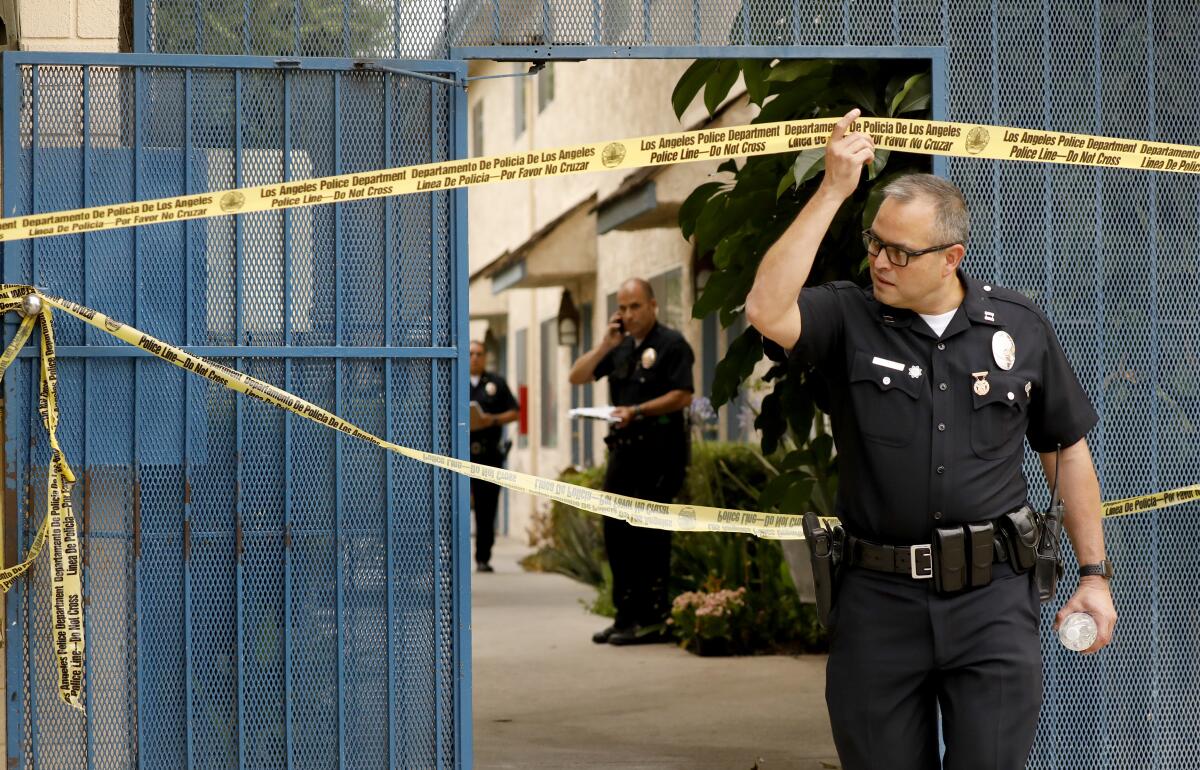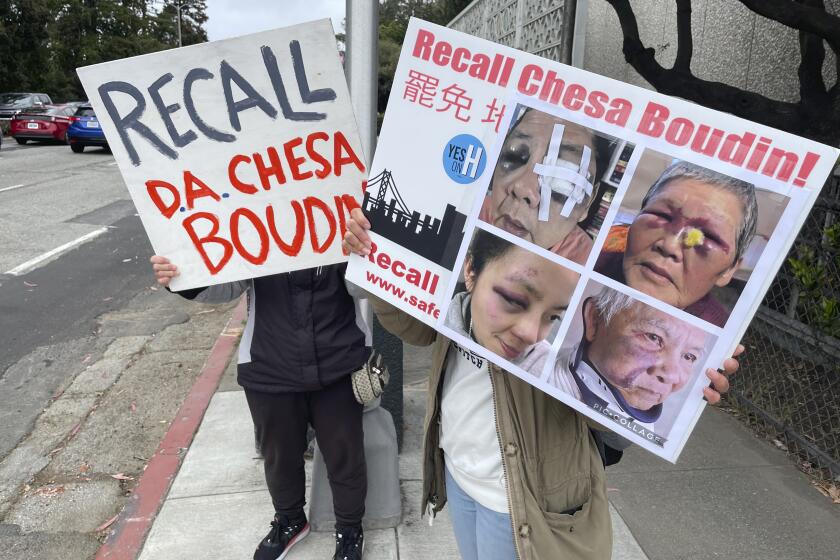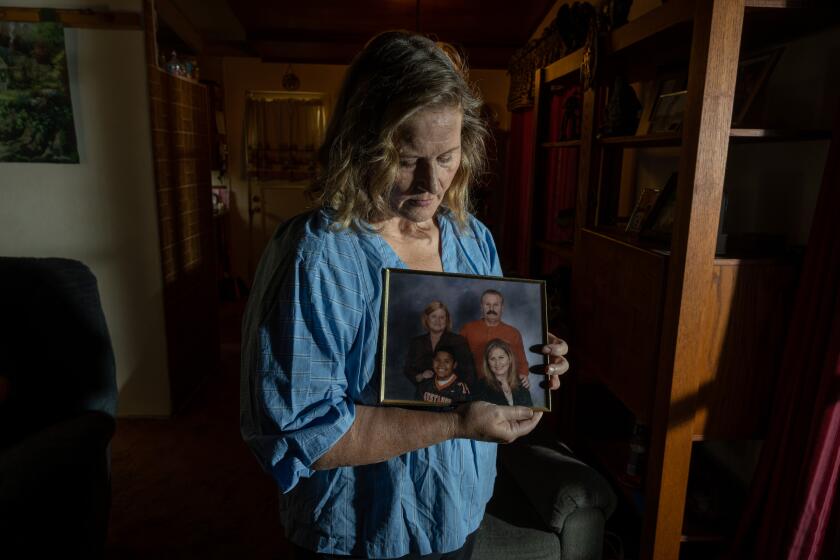Column: Violent crime is spiking in Trump’s California. These counties blame everyone but themselves

- Share via
Homicides are up across California and the blame experts are aiming their outrage at the usual suspects.
Gavin Newsom. Propositions 47 and 57 for lowering penalties on nonviolent crimes and facilitating early prison releases. Progressive district attorneys. Democrats.
But deeper in the data, released Thursday by state Atty. Gen. Rob Bonta, is a more complicated story, one that defies those easy narratives of a failed California with its recklessly unsafe efforts at criminal justice reform. The biggest risks for homicides came in conservative counties with iron-fist sheriffs and district attorneys, places where progressives in power are nearly as common as monkeys riding unicorns.
Kern County leads the locales where your chance of being murdered is greatest — with a homicide rate of nearly 14 people per 100,000, compared with about 6 per 100,000 for the state as a whole and 8.5 per 100,000 in Los Angeles County. The number of people annually murdered (a legal term that implies conviction, but you get my point) in Kern has nearly doubled since 2015 to 124 lives last year.
Former President Trump, who legitimately lost the 2020 election, won nearly 54% of the count in Kern. Trump sycophant and House Minority Leader Kevin McCarthy also prevailed handily in Kern, raking in 64% of votes. My colleague Gustavo Arellano profiled Kern County Sheriff Donny Youngblood, pointing out that he’s a dying breed of old-school lawman, not one to take the soft approach.
Merced County had the second-highest homicide rate at 9.5 per 100,000 residents. Merced is a political mixed bag, as a “blue wave” of Bay Area refugees and political converts have turned this agricultural stronghold into a nearly equally split county, but one where Democrats are far from a shoo-in to win any election.
Third place goes to Tulare County, running from Delano in the south to a bit north of Visalia, where people were violently killed at a rate of 8.8 per 100,000. Trump took nearly 53% of the vote there in 2020, and McCarthy, who also represents part of the area, took nearly 59%. Recently, after two suspects in a fentanyl bust were released on bail, Tulare County Sheriff Mike Boudreaux told Fox News that “California’s system of justice is failing us all.”
It’s safe to say that none of these counties coddle their criminals — presidential leanings don’t define policy, but they are an indicator of how local politicians and law enforcement think about and handle crime. And yet, not only do these counties share the same problems of dark-blue Los Angeles and San Francisco — poverty, homelessness, drugs — they are doing worse on homicides. That’s true, even given the fact that a few killings in less-populated counties can mean big jumps in year-to-year statistics.
Some say Chesa Boudin’s recall spells doom for reformist prosecutors. But would we really return to the days of over-incarceration and bias?
At the other end of the spectrum is Contra Costa County, which has been successful at beating state averages on crime and has one of the state’s only (along with L.A.’s George Gascón) openly progressive district attorneys, Diana Becton.
Despite an unapologetic focus on “moving beyond a singular narrative of incarceration being the answer to everything,” she told me, the county is holding its own when it comes to safety.
Contra Costa’s murder rate increased slightly from last year — but remains around 4 per 100,000 residents.
So the idea that progressive policies lead to more violent crime just doesn’t pan out, any more than the idea that getting tough dissuades criminals.
Where does that leave us in understanding the numbers?
There are two things we should talk about: guns and NIMBYism.
First, we are swimming in guns. Drowning in them. Becton told me there are now “more guns in the hands of people than I think in history.”
The vast majority of our homicides and aggravated assaults involve guns — in 1,734 out of 2,361 homicides recorded in California in 2021, the weapon was a gun, a 33% increase in firearm-related homicides since 2012. That means about 75% of the time when a Californian is murdered, the cause of death is a bullet. So-called ghost guns, legal guns, automatics, shotguns. You name it, someone committed a crime with it.
Save me your 2nd Amendment emails. I have nothing against legal, responsible gun ownership. But a lot of people who shouldn’t have firearms — because they are felons, domestic abusers, have mental health issues, or are getting ready to open fire on a large crowd, for example — have them anyway. We make it easy.
Becton thinks we need to sit down and prioritize the gun problem, and I couldn’t agree more. Yes, cops take guns away every day and we have a Armed and Prohibited Persons System meant to help remove illegal guns from about 24,500 people who legally purchased weapons but are no longer allowed to keep them.
Bonta said Thursday that his office is overseeing $10 million in grants to sheriffs to help confiscate those guns, but those efforts are like spitting on a forest fire.
We also have a problem with our criminal justice reforms. Just not the ones guys like Sheriff Boudreaux target.
Racist before reforms and still, our system has locked up people of color at alarming rates, while criminalizing health issues including addiction and mental illness. So the changes we’ve put in place to create equity, fairness and compassion are vital to reimagining a paradigm that for too long crushed not just people, but communities.
Where we’ve failed is in supporting and implementing those reforms. When someone is released from prison, diverted from jail or is the victim of a crime, that can’t be the end of the story.
What we lack is capacity to create stability for them — addiction treatment, mental health support, housing, job training, social workers. It’s the same safeguards we lack in other crises such as homelessness, all made worse by the pandemic, crushing nearly everyone under its stress and pain and exhausting the resources we do have.
“Too much, too fast, too little support” is how Yolo County Dist. Atty. Jeff Reisig describes what’s happened with California’s efforts at criminal justice reform. He’s also president of the California District Attorneys Assn., and a middle-of-the-road kind of guy when it comes to justice.
“It doesn’t mean we have to send everyone back to prison, but it means we have to do the tweaks to get people into programs like Care Court,” he said, calling out Newsom’s plan for a system of civil courts to help those with severe mental illness.
Gov. Gavin Newsom has proposed civil courts to help people with severe mental illness. Critics call it ‘forced treatment’ — but that misses the point.
But I’m starting to think we don’t want to change as much as we say we do.
Most Californians are liberal at a distance, but bring it too close and it just doesn’t make sense here. There may be no better example than the San Francisco neighbors who last year successfully blocked the conversion of a 131-room boutique hotel into permanent supportive housing for people who were previously homeless.
Or what happened a few years ago in Bakersfield when the local hospital protested allowing homeless people to stay in a hotel in an industrial area because it was too close to an employee parking lot.
That intolerance has created an impossible-to-untangle mess of crime, housing, mental health and addiction that endlessly churns around us — all at heart different angles of poverty, race and inequity. People of color are disproportionately among the ranks of our homeless, incarcerated, mentally ill and addicted, and the vast majority of murder victims are Black and Latino.
We are faced with either accepting the solutions really are in our own backyards or embracing the so-called pendulum swing back to solutions that sweep the impoverished behind bars where we don’t have to look at them. Guess how that plays out in conservative places like Kern, Merced and Tulare where poor people of color have long been viewed as suspect, and where the poverty rate hovers near 20%, significantly higher than the state average of about 12%?
Everything is not bleak, thankfully. The figures released this week are outdated, according to Mike Romano, director of the Three Strikes and Justice Advocacy Projects at Stanford Law School. Newsom appointed Romano as chair of California‘s Committee on the Revision of the Penal Code in 2019.
Romano and his team conduct nearly real-time tracking of available crime data in California, so he’s already looking at 2022. So far, he’s seen homicides trend down or stay flat in some of our biggest cities.
Fresno, he said, has seen a huge drop of 29% so far this year. Oakland is down 6%. Los Angeles and San Francisco have remained about even year-over-year. Long Beach and San Diego have ticked up. Other crimes, including robbery, burglary, shoplifting and arson, were all flat or down across the state in 2021, he said.
Overall, violent crime in California is the lowest it’s been since the 1970s, and has been that way for at least 10 years. California has the second-lowest homicide rate of any of the 10 largest states after New York, less than half the rate of states including Illinois, Georgia and Ohio.
We are significantly safer than most other big states, even after a decade of major changes to our carceral system.
So criminal justice reform may be the easiest focus of blame for why some violent crime is up.
But it turns out guns really do kill people, regardless of what the right likes to argue.
And so does NIMBYism, though it’s an uncomfortable culprit to name.
More to Read
Sign up for Essential California
The most important California stories and recommendations in your inbox every morning.
You may occasionally receive promotional content from the Los Angeles Times.













